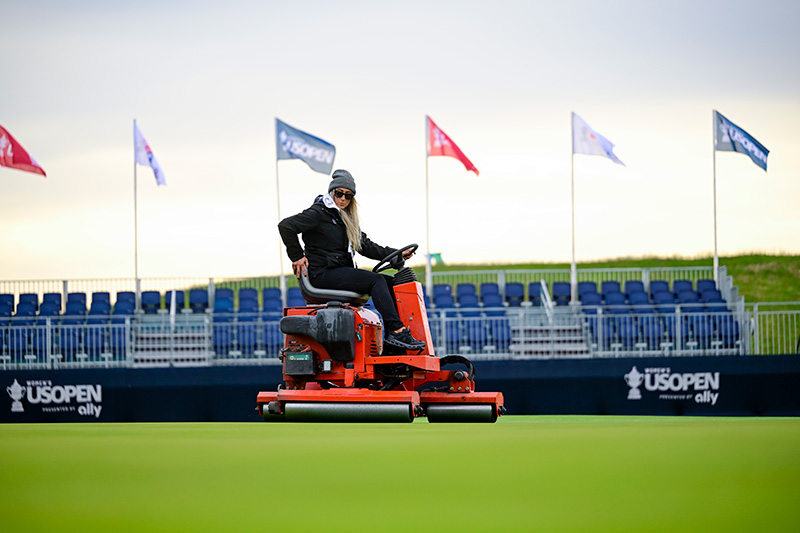
Kate Lifke is the superintendent at Trappers Turn Golf Club in Wisconsin Dells. Wis., and a former intern at Erin Hills Golf Course, where the U.S. Women's Open takes place this week.Logan Whitton/USGA
The U.S. Women’s Open is a full-circle moment for Kate Lifke.
Lifke, superintendent at Trappers Turn Golf Club in Wisconsin Dells, Wis., was an intern at Erin Hills Golf course — site of the 2025 U.S. Women’s Open — in 2008 and 2009. She also served on the volunteer maintenance crew in 2017 when Erin Hills hosted the men’s U.S. Open.
“I was one of five women when I was here in 2017,” says Lifke, a six-year GCSAA member. “Now there are 32 of us.”
Of course, the circumstances are different. Lifke has a short road trip to Erin Hills as part of the female-heavy maintenance crew, a practice that’s become something of a tradition at the Women’s Open since director of golf maintenance Troy Flanagan brought in a mostly women’s crew for the 2021 event at The Olympic Club in San Francisco.
“Walking into a tent full of men can be intimidating,” Lifke says, recalling that 2017 Erin Hills experience. “It’s nice to have people you can talk to.”
Lifke is superintendent at Trappers Turn GC’s 12-hole par-3 course, 12North. TTGC also has three nine-hole courses. It’s located just over 1 1/2 hours from Erin, Wis. — close enough that Lifke plans to spend the week bouncing between the two courses.
“A lot of driving,” she says. “But it’s a sacrifice I’m willing to make to participate in an event like this. It’s long days. It’s exhausting. But it’s exciting.”
It’s also exciting, Lifke says, to see the 32 women who are part of the 85-person volunteer crew.
“For so many years, going to the state thing, the national show … there weren’t many of us,” Lifke says. “But in the last five years, there’s been a big push to get more women in the industry.”
This year’s women’s contingent skews young. Of the 32 participants, 20 are assistants, second assistants, assistants-in-training, students or interns. Just six are superintendents.
“I feel old,” Lifke says with a laugh. “But you can feel their energy. This is their first time. It’s nice to see their energy.”
Like many superintendents, Lifke fell into the profession. When she headed off to college to become a landscape architect, she says, “I didn’t know people went to college for this.”
Bored with the prospect of sitting in a drafting room, Lifke entertained golf course design as a career, but that coincided with the recession of 2008 and the associated cooldown in course construction.
“I had an adviser who asked if I’d be interested in golf course maintenance,” Lifke recalls. “I’d never golfed, never been on a golf course.”
The adviser found Erin Hills, where Zach Reineking — now the course’s GCSAA Class A senior director of course maintenance, and an assistant at the time — was willing to bring Lifke on as one of two interns.
“I was more focused on the sustainability aspect,” Lifke says.
She eventually grew to love the profession, even if she questioned her place in it.
“A couple of times, I second-guessed myself,” she says. “I wondered if it was going to be acceptable to step away for a couple of years to have children; would I have a chance if I was competing for a position?”
A chat with Reineking convinced her she would.
“I remember him saying, if he had an opening, and he had résumés from a male and a female in front of him, and they were the same in experience, he said, ‘I’d probably go with the female, because women usually have a better eye for detail,’” Lifke says. “He made me feel more confident.”
Reineking, a 22-year GCSAA member, recalls their discussion, which Lifke says still motivates her now.
“Kate was uneasy about going into the turf industry that’s so dominated by males. I told her it would be a good thing for her, but that was 15 years ago,” Reineking says. “I told her, ‘If you’re good and a hard worker, it won’t matter.’ And I believed it. But that was 15 years ago. The industry wasn’t as accepting. She was ahead of her time. To see how many females are part of our industry now, it’s exciting.”
Now that she’s among the veterans, Lifke says she’s comfortable serving as a role model.
“If I had to give one piece of advice, it would be, ‘Never doubt yourself and stick to it,’” Lifke says. “I think a lot of females think they have to show up and give 150% and outwork everybody. Just keep working. Just grind.”
Andrew Hartsock is GCM’s editor-in-chief.